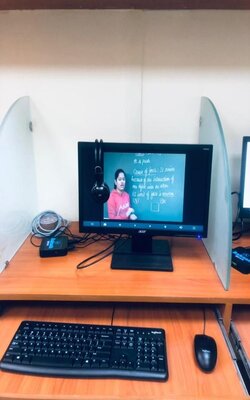How digitalization is shaping education in India

Sandeep Dham is a Post-Graduate from IIM Ahmedabad. He has more than 23 years of leadership experience spread across leading Indian and multinational corporations in the field of Retail, Logistics and Information Technology. He has considerable experience in designing and launching of new products and services as well.
The Earlier Era
Traditional teaching was focused on imparting knowledge to students predominantly through lectures. Teachers used chalk and board and verbal cues andgestures to impart learning. Students transcribed notes to reinforce knowledge. This was followed by periodic tests to assess the gaps in learning. Such learning lacked the consistency of academic delivery and support from pictures, diagrams and videos.
The Digital Age
Digitalization has changed all that. It uses digital technology on both the hardware and software front to teach students of all ages.The coronavirus pandemic has quickened the pace of digitalization. The digital mode provides learning at a more flexible pace. Various modules can be covered in the differential pace of teaching as per learners’ comfort.
Digitalization works as a force multiplier enhancing reach, especially in Tier 2 and Tier 3 cities.
Digital mode enables periodic updates to teachers where the latest knowledge updates and scientific advances are promptly communicated to a distributed teacher base.
Digital enables easier visualization. In STEM (Science, Technology, Engineering & Mathematics) diagrams, formulae, and pictures play an important role. Digital can provide multi-colour diagrams, detailed diagrams, complex formulae, etc., to enhance learning.
Testing in multiple modes is easier, the ability to create questions, subjective MCQ, Multi-Concept Questions, and the ability to mix tests with varying degrees of difficulty. Generating results and providing feedback is faster, providing the ability to create personalized learning. With multiple technologies from interactive whiteboards, to interactive LEDs, aided by high-resolution cameras, the learning experience is enhanced.
Revision and reinforcement of knowledge are made easier by digital storage of content ensuring not only anytime learning, but also re-learning.
Digital ensures easier collaboration across distances, and cross-pollination of ideas across multiple learning levels. The digital mode of learning encourages curiosity, innovation and thinking.
Digital platforms help to smooth academic operations, like scheduling classes, providing information updates to all stakeholders and managing changes.
Aakash + BYJU’Sis at forefront of digital adoption across all levels. Digitalization is across all levels from content creation is generated via CMS (Content Management System), which enables Multiple test platforms for students’ test experience. Detailed digital lecture notes also ensure seamless facilitation of academic delivery. Aakash + BYJU’S has 100% of digitally enabled and equipped classrooms. Students get access to a complete digital database of all lectures with visual aids for easier understanding. Learning is enhanced via doubts clearance, Aakash+BYJU’S learning model facilitates doubts clearance, across multiple platforms.


In summary digital learning empowers efficiency &productivity, & encourages students to learn at their own pace.
Challenges of Digital Education
The biggest challenge in digital education is the Digital Divide. Students across different strata of society are not able to access digital education due to a lack of economic resources. This issue is further exacerbated due to connectivity challenges across different geographies and faster-uninterrupted access requiring higher economic resources.
A key concern is ensuring the privacy of students, and how to ensure access control ensuring digital safety. Higher safety standards ensuring data standards will be crucial to ensure the proper utilisation of digital advantages.
Another key challenge in the digital mode of education is enabling learning for introverted students, extra efforts need to be put in to ensure their learning is not impacted.
Parents are crucial facilitators and enablers. Ensuring parents are a part of the roadmap, crucial for implementation, and ensuring regular progress updates are provided to parents is essential.
Way Forward
The future of education is a hybrid leveraging the benefits of both the in-person and virtual worlds. Further, emerging technologies, like 3D, and Metaverse and their impact on education will continue to enhance how we deliver learning for the student. The New Education Policy encourages the use of Digitalisation, and how that impact needs to be observed. The use of advanced analytics will further enhance the impact of digital learning.

